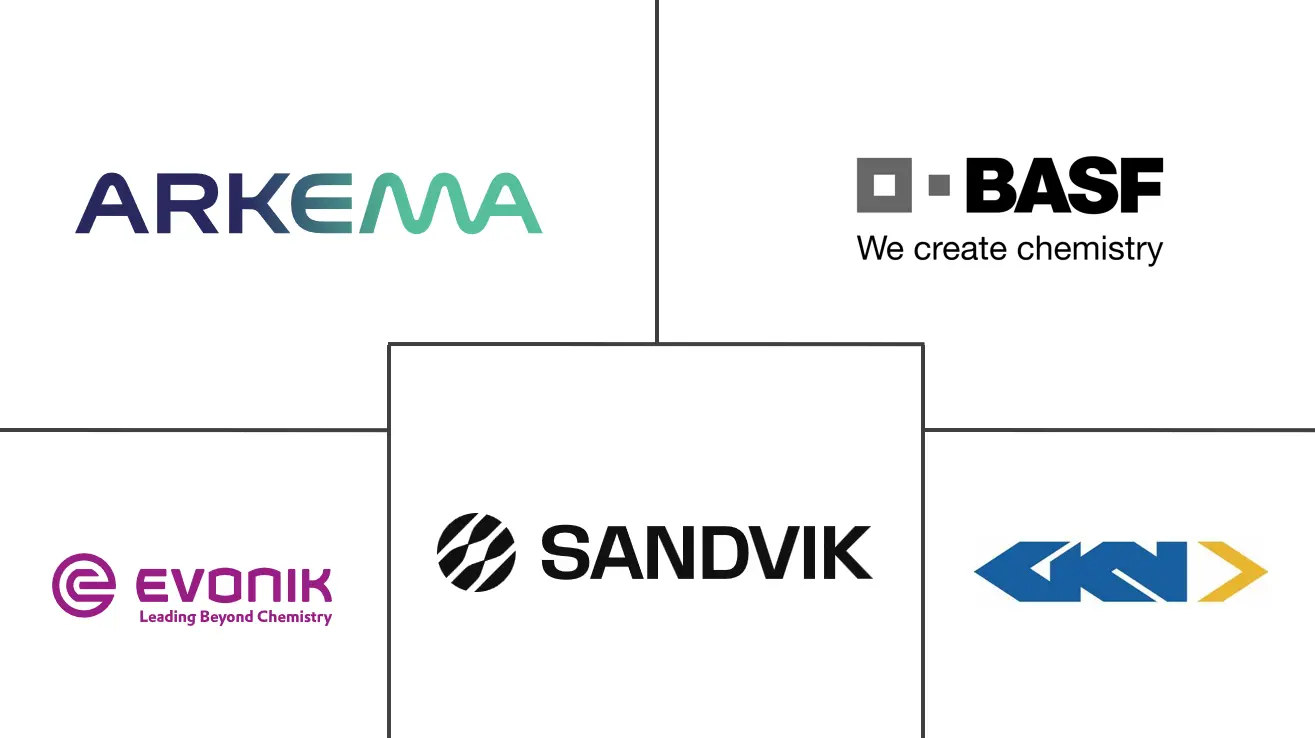3D Printing Powder Market Size and Share
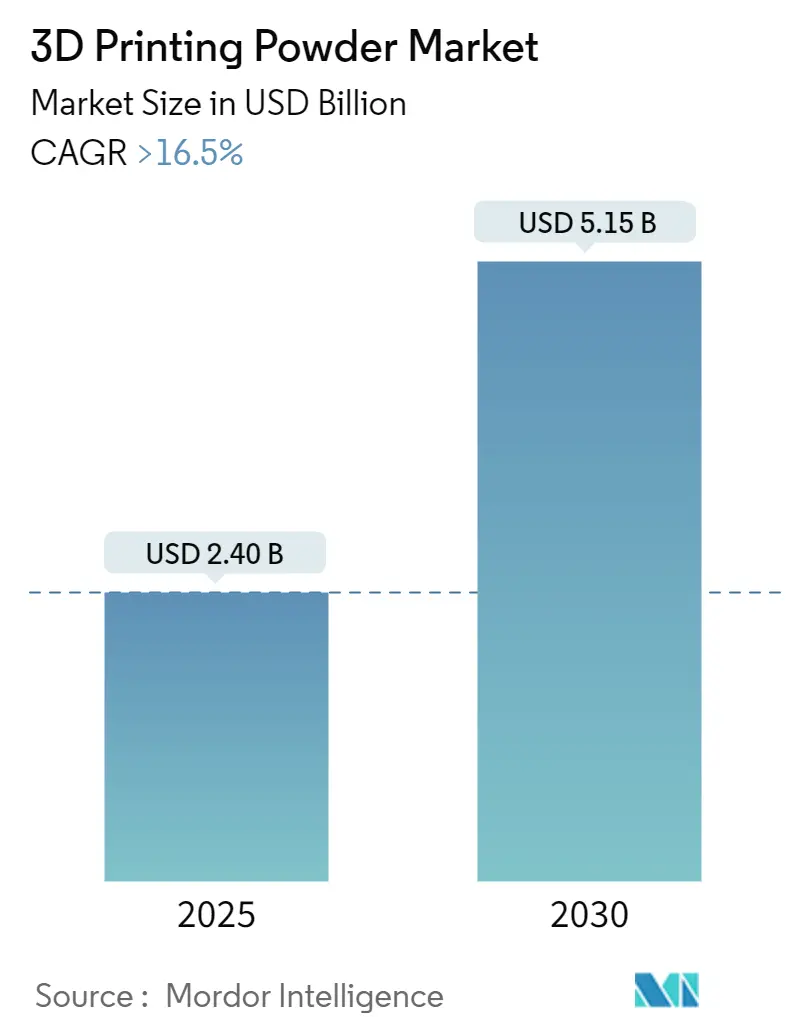
3D Printing Powder Market Analysis by Mordor Intelligence
The 3D Printing Powder Market size is estimated at USD 2.40 billion in 2025, and is expected to reach USD 5.15 billion by 2030, at a CAGR of greater than 16.5% during the forecast period (2025-2030).
The COVID-19 pandemic had a mixed impact on the 3D printing powder market, presenting challenges but also creating opportunities for innovation and growth. The pandemic accelerated the acceptance of 3D printing in various industries, such as healthcare, and the long-term impact is expected to be positive. It is because companies invest in 3D printing technologies and materials to enhance their operations and resilience.
- The pandemic spurred demand for 3D printing powders used in medical applications. It is a major driving factor for this market, such as creating prototypes of medical devices and manufacturing personal protective equipment (PPE).
- Despite the transformative potential of 3D printing, the widespread adoption of this technology is hindered by the high material and post-processing cost of 3D printing powder.
- The ability to print with multiple materials in a single process is gaining traction, allowing the creation of products with more complex structures and functionalities. It will provide an opportunity for 3D printing powders that are compatible with multi-material printing processes.
- The Asia-Pacific region dominated the market for 3D printing powder, with China, India, and Japan being the major contributors to the market demand.
Global 3D Printing Powder Market Trends and Insights
Growing Demand from Automobile Sector
- The automotive industry is a primary industry that utilizes this technology, holding a significant share in the end-user industries segment. Over the years, the automotive sector extensively employed this technology for the rapid production of prototype equipment and small custom products. Its widespread use is particularly notable in the manufacturing of lightweight components for both automobiles and Original Equipment Manufacturers (OEMs).
- 3D printing powder is used in different processes in additive manufacturing. It is being majorly used in automobile, aerospace, and defense products. 3D printing hardware builds an object by selectively sticking together successive layers of excellent powder.
- Various forms of powder adhesion are commonly used to 3D print, using a wide range of materials. These include nylon, bio-plastics, ceramics, wax, bronze, stainless steel, cobalt chrome, and titanium.
- 3D printing powder finds applications in the automobile sector in the form of housing and brackets, turbochargers, tire molds, transmission plates, and control valves and pumps. It also includes applications in cooling vents, body panels, dashboards, seat frames and prototyping, bumpers, and other engine components.
- Also, 3D printing powder helps in vehicle weight reduction processes that support increasing the performance and efficiency of the vehicles.
- As per OICA, the Global Automotive Industry is currently growing at a substantial rate of 6% in 2022 over 2021. In 2022, various developed and developing countries across the world, including China, Germany, South Korea, Canada, the United Kingdom, and Italy, experienced an increase in automotive production. In 2022, over 85.02 million units of Motor vehicles were manufactured.
- The Chinese automotive manufacturing industry is the largest in the world. The industry witnessed a slight increase in 2021, with a 3% increase in 2022, wherein production and sales inclined. According to the China Association of Automobile Manufacturers (CAAM), the production of passenger cars increased by 11.2% in 2022 over 2021.
- Increasing applications for rapid prototyping, growing demand for the aerospace sector, and technological advancements in automobiles in developing regions are driving the demand for the 3D printing powder market through the years to come.
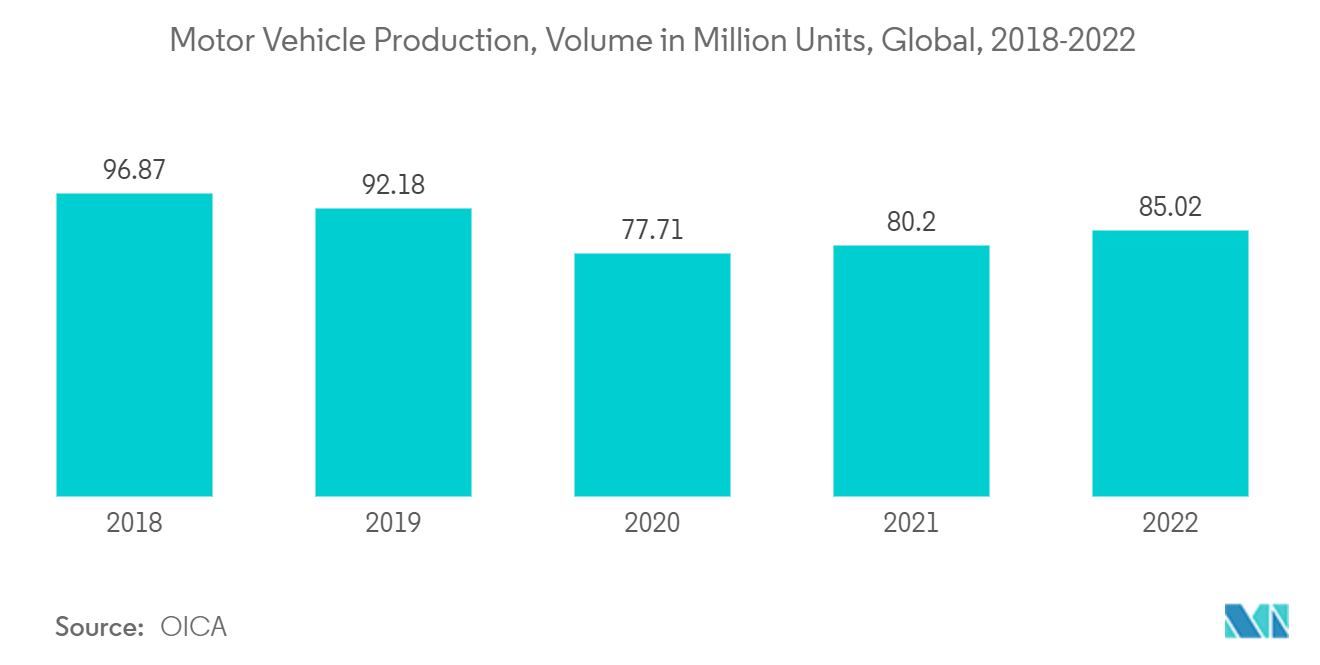
Asia-Pacific Region to Dominate the Market
- Asia-Pacific is expected to dominate the global market owing to the highly developed automobile sector in China, Korea, Japan, and India. It is coupled with the continuous investments done in the region to advance medical and aerospace technologies through the years.
- As per the Society of Indian Automobile Manufacturers, the Automotive Industry in India manufactured a combined total of 25.93 million vehicles. The vehicles include passenger vehicles, commercial vehicles, three-wheelers, two-wheelers, and quadricycles during the period from April 2022 to March 2023, in comparison to 23.04 million units produced from April 2021 to March 2022.
- 3D printing powder can be used for manufacturing various components in the aerospace sector. It includes transition ducts, engine components, aircraft landing gear rotor blades, spray bars, flame holders, liners, carrier rings, and corrosion-resistant components.
- The growing production and assembly bases for aerospace components in the Asia-Pacific regions in recent years are expected to provide scope for the consumption of 3D-printed components and powders in the near future.
- As per the General Aviation Manufacturers Association, there was an 8.2% rise in piston airplane deliveries in 2022 compared to 2021, totaling 1,524 units. Turboprop airplane deliveries increased by 10.4%, reaching 582 units, while business jet deliveries experienced a marginal increase from 710 to 712 units. The total value of airplane deliveries in 2022 amounted to approximately USD 22.9 billion. It reflected a growth of around 5.8% over the previous year.
- In Asia-Pacific, the growth in medical technology in developing countries is immense. The need for customized implants like tooth crowns, hearing aids, and orthopedic replacement parts is supporting the expansion of the medical industry.
- The growth in aerospace and defense sectors in China, Japan, Korea, and India increased the architectural and construction industries in developing countries. The tremendous growth in the medical sector is expected to drive the market for 3D printing powder through the years to come.
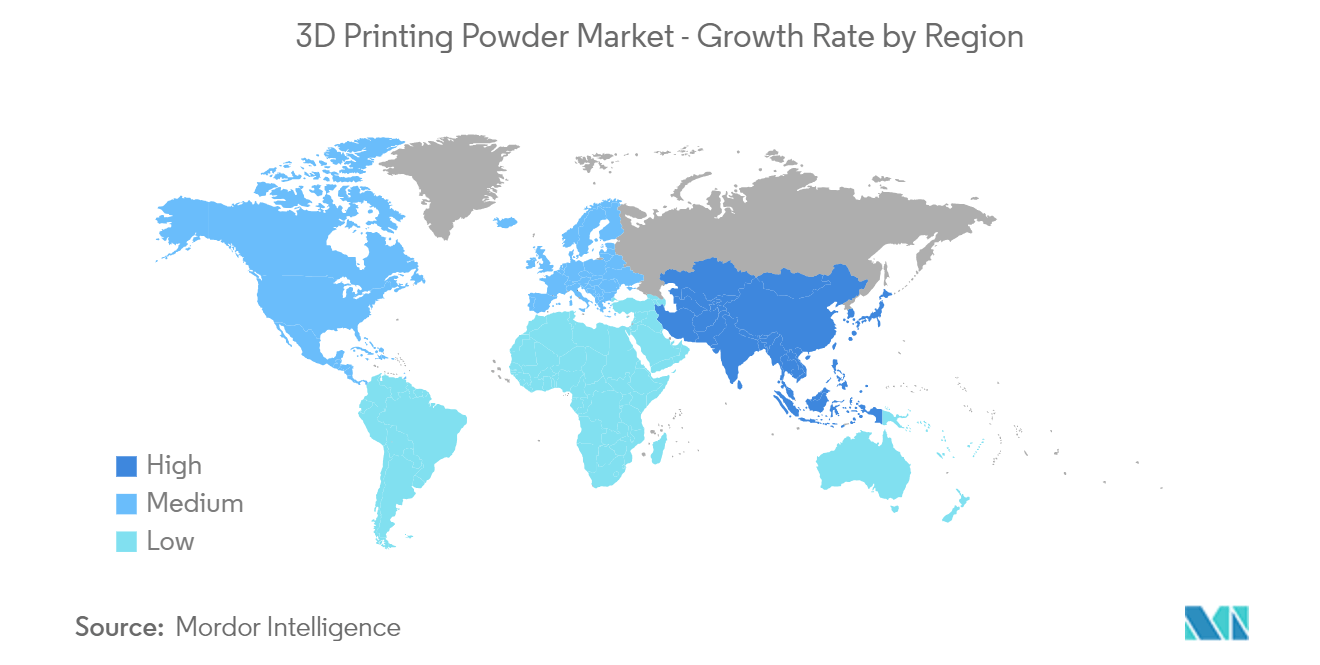
Competitive Landscape
The 3D printing powder market is partially consolidated in nature. The major players (not in any particular order) include Sandvik AB, Arkema, BASF SE, GKN Powder Metallurgy, and Evonik Industries AG, among others.
3D Printing Powder Industry Leaders
-
Sandvik AB
-
Arkema
-
BASF SE
-
Evonik Industries AG
-
GKN Powder Metallurgy
- *Disclaimer: Major Players sorted in no particular order
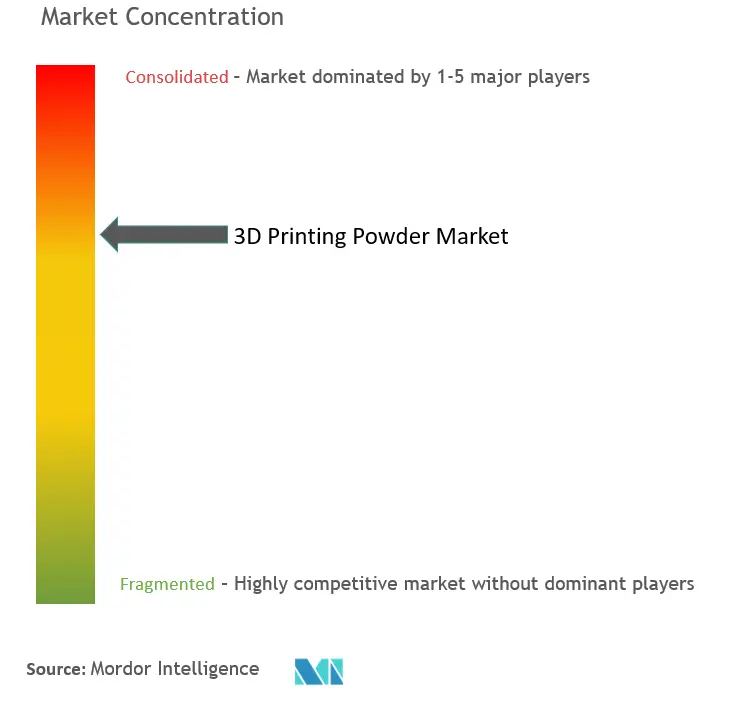
Recent Industry Developments
- :
- :
Global 3D Printing Powder Market Report Scope
Three-dimensional (3D) printing powder is a material utilized in additive manufacturing processes to produce 3D objects. Commercially manufactured from steel, aluminum, titanium, alloys, and plastics, among others, this powder is extensively employed in crafting structural components, turbine blades, engine parts, suspension elements, hearing aids, sports equipment, etc. Renowned for its high strength, exceptional durability, favorable biocompatibility, and resistance to wear, corrosion, and moisture, 3D printing powder plays a crucial role in cost reduction, time savings, waste minimization, efficiency enhancement, and the promotion of sustainability.
The 3D printing powder market is segmented by powder type, end-user industry, and geography. By powder type, the market is segmented into plastic powder, metal powder, ceramic powder, glass powder, and other powder types (composite powder, etc.). By end-user industry, the market is segmented by automotive, aerospace and defense, medical, architecture, and other end-user industries (consumer goods, industrial, etc.).The report also covers the market size and forecast for the 3D printing powder market in 15 countries across major regions. For each segment, the market sizing and forecasts are done on the basis of Value (USD).
| Plastic Powder |
| Metal Powder |
| Ceramic Powder |
| Glass Powder |
| Other Types (Composite Powder, etc.) |
| Automotive |
| Aerospace and Defense |
| Medical |
| Architecture |
| Other End-user Industries (Consumer Goods, Industrial, etc.) |
| Asia-Pacific | China |
| India | |
| Japan | |
| South Korea | |
| Rest of Asia-Pacific | |
| North America | United States |
| Canada | |
| Mexico | |
| Europe | Germany |
| United Kingdom | |
| France | |
| Italy | |
| Rest of Europe | |
| South America | Brazil |
| Argentina | |
| Rest of South America | |
| Middle-East and Africa | Saudi Arabia |
| South Africa | |
| Rest of Middle-East and Africa |
| Powder Type | Plastic Powder | |
| Metal Powder | ||
| Ceramic Powder | ||
| Glass Powder | ||
| Other Types (Composite Powder, etc.) | ||
| End-user Industry | Automotive | |
| Aerospace and Defense | ||
| Medical | ||
| Architecture | ||
| Other End-user Industries (Consumer Goods, Industrial, etc.) | ||
| Geography | Asia-Pacific | China |
| India | ||
| Japan | ||
| South Korea | ||
| Rest of Asia-Pacific | ||
| North America | United States | |
| Canada | ||
| Mexico | ||
| Europe | Germany | |
| United Kingdom | ||
| France | ||
| Italy | ||
| Rest of Europe | ||
| South America | Brazil | |
| Argentina | ||
| Rest of South America | ||
| Middle-East and Africa | Saudi Arabia | |
| South Africa | ||
| Rest of Middle-East and Africa | ||
Key Questions Answered in the Report
How big is the 3D Printing Powder Market?
The 3D Printing Powder Market size is expected to reach USD 2.40 billion in 2025 and grow at a CAGR of greater than 16.5% to reach USD 5.15 billion by 2030.
What is the current 3D Printing Powder Market size?
In 2025, the 3D Printing Powder Market size is expected to reach USD 2.40 billion.
Who are the key players in 3D Printing Powder Market?
Sandvik AB, Arkema, BASF SE, Evonik Industries AG and GKN Powder Metallurgy are the major companies operating in the 3D Printing Powder Market.
Which is the fastest growing region in 3D Printing Powder Market?
Asia Pacific is estimated to grow at the highest CAGR over the forecast period (2025-2030).
Which region has the biggest share in 3D Printing Powder Market?
In 2025, the North America accounts for the largest market share in 3D Printing Powder Market.
What years does this 3D Printing Powder Market cover, and what was the market size in 2024?
In 2024, the 3D Printing Powder Market size was estimated at USD 2.00 billion. The report covers the 3D Printing Powder Market historical market size for years: 2019, 2020, 2021, 2022, 2023 and 2024. The report also forecasts the 3D Printing Powder Market size for years: 2025, 2026, 2027, 2028, 2029 and 2030.
Page last updated on:
3D Printing Powder Market Report
Statistics for the 2025 3D Printing Powder market share, size and revenue growth rate, created by Mordor Intelligence™ Industry Reports. 3D Printing Powder analysis includes a market forecast outlook for 2025 to 2030 and historical overview. Get a sample of this industry analysis as a free report PDF download.
